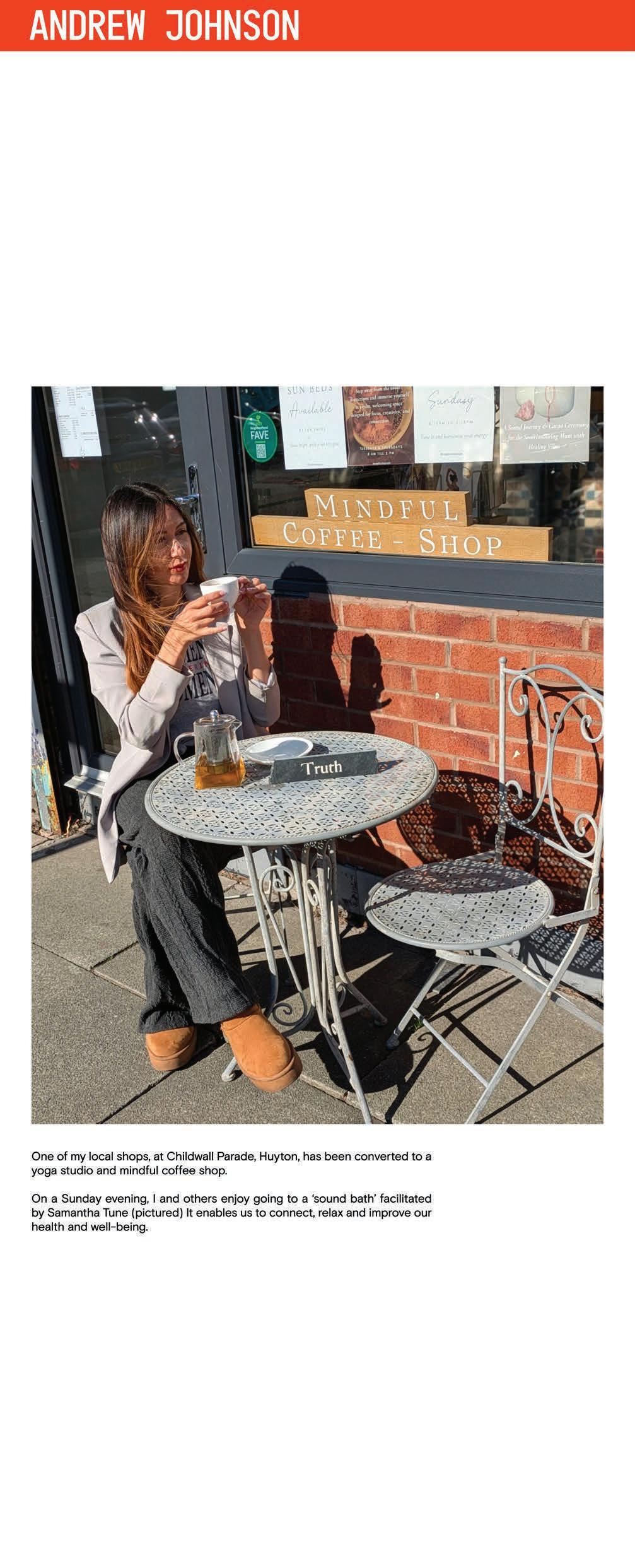COMMUNITIES OF WELCOME



For six months, Anoosh Ariamehr, photographer-in-residence, has been working with a group of Knowsley residents at Huyton Library. Through weekly workshops, Anoosh has supported the group to develop their skills as photographers and artists via workshops, gallery visits and discussion.
The group – Communities of Welcome – became a space for people from diverse cultural and social backgrounds to celebrate their own differences and commonalities. during this time, the group have used photography to explore their local area, encourage each other and to highlight their own lived experiences of locality and displacement.
Communities of Welcome is part of Photo Here, a programme of socially engaged photographic residencies and exhibitions commissioned by Liverpool City Region Combined Authority as part of 2025 Cultural Events Programme. Developed by Open Eye Gallery in collaboration with each of six local authorities: Halton, Knowsley, Liverpool, Sefton, St Helens and Wirral.
OCTOBER 2025
JR-W: How did you start working as a photographer and with Open Eye Gallery?
AA: I arrived in the UK from Greece in 2019 with a camera and a backpack. After a week, I moved to Liverpool. A few months later, the COVID pandemic struck, and I was stuck at home for nearly two years. I started volunteering with Whitechapel Centre, and at that time I was dealing with very bad depression. My language was also very limited at the time, so I tried to keep myself busy. Using my phone and camera, I walked around the Waterfront taking pictures every day.
One night in November 2022, I happened to come across the private view of the Sony World Photography Awards exhibition at Open Eye Gallery. It was a free event, so I decided to go inside. During the opening dinner, I noticed a table full of people and found myself sitting near Sarah Fisher, Executive Director of Open Eye Gallery. She smiled at me, I smiled back, and she asked, ‘Are you a photographer?’ I replied, ‘Not exactly – I try to be.’ She then asked where I was from, and I told her I was from Afghanistan. That sparked a conversation about my journey and experiences, including my time in Turkey and Greece.

Sarah was genuinely pleased to meet me. She explained that while the gallery didn’t have any paid opportunities, volunteering was a great way to get involved, and that the gallery could help if I was interested in socially engaged photography. To be honest, it was the first time I heard about socially engaged photography; it was completely new to me. But I was interested. The next day, I applied to become a volunteer. By February 2023, I had started volunteering, greeting visitors at the front desk.
Each day, I learned more about socially engaged photography. Working at the front desk helped me engage with different people who visited the gallery. It was a valuable experience that deepened my understanding of Liverpool, British history and culture, and photography, while also helping me improve my English.

JR-W: Were you immediately drawn to socially engaged photography when you were introduced to it?
AA: For three or four months, I didn’t fully digest the meaning of socially engaged photography. It’s not easy. Open Eye Gallery didn’t push me or force me to embrace it. They let me learn day by day on my own terms. I didn’t force myself either. I just tried to process the information and processes.
Sometimes we had chats with Sarah and the staff. One day, Sarah said, ‘Now is the time we can help you develop as a socially engaged photographer.’ Before that, we had talked about refugees and displaced communities in Knowsley. I shared my perspective as a refugee, the barriers and situations that newly arrived communities face. From this, Open Eye Gallery supported me to use my experiences to start working with refugee communities through photography.
My first project was Hidden Voices with SHARe Knowsley. It was a pilot project for both sides. At first, I thought socially engaged photography was about professionalism and perfectionism. I slowly learned that it’s about process, not a polished outcome. I understood what socially engaged photography is. I connected it with my experiences in Afghanistan. I realised it’s the exact fit – I’m an activist; I fight for social justice.
My second project was New Faces, New Focus, as part of Going Places, a new project which aims to engage and involve underrepresented audiences in museum collections through collaborative touring exhibitions. I delivered a pilot project in 2024, working with newly arrived people from Africa, Ukraine, Afghanistan, Syria and Iraq.
The Photo Here project was in development in 2024. I was selected as the artist for Knowsley, where I have been living for several years. It was a great opportunity – the right project at the right time. It became my first artist residency in Knowsley.
JR-W: How did you find the residency model?
AA: It was straightforward in some respects but challenging in others. I know the reality on the ground and the challenges refugees face. In my two previous projects, sometimes we started with 10 people and ended with one or none. Newly settled people have complex lives that change daily. It can be hard for them to commit to meeting regularly.
I suggested that working only with refugees doesn’t work. We need to integrate them with local communities. Running separate projects can reinforce social divides, when what we really need are compassionate projects that bring displaced and local communities together to learn from one another. Social media misinformation has created negative perceptions of both refugees and local communities. To overcome this, we need to break down cultural, linguistic, religious and financial barriers and create opportunities for genuine connection.
To begin, we recruited participants with the support of different partners in Knowsley and started the workshops in mid-January. Travelling between towns in Knowsley on public transport can be difficult. Huyton Library became our home for these workshops; it felt like a safe space for us to meet and share our stories. At first, people said it was noisy. But it’s about trust. Once trust is built, people can relax and focus. Libraries are vital public spaces. They are safe and provide a welcoming atmosphere.
JR-W: How were your experiences working with a diverse group of Knowsley residents?
AA: I use the term ‘community members’ instead of participants. Many came to the group bringing their own challenging experiences, so building trust was important. This became the project’s signature. We proved we are welcoming to everyone, even those who disagree. Open, respectful conversation lowers barriers. I connected strongly with that because I had the same experience.
I designed the weekly sessions as a mix of learning, dialogue and practice. Socially engaged photography is two-sided learning and not passive teaching. Community members should be active in this process, and our group was. I learned so much from their challenges, perspectives and life experiences.
Ultimately, it’s about empowering people. I provided new skills and knowledge of how to use their mobile phone to help them tell their stories meaningfully.


JR-W: The project title, Communities of Welcome, comes from a place of empathy. I felt that was one of the core attributes you brought to the project, from providing multilingual session content to community members to your care and openness throughout.
AA: Yes, but I also challenged and encouraged them. I believe in learning from each other. I’m a facilitator, not a leader. The outcome was community-driven, not mine. I felt proud. In a short time, we had a range of powerful photography works that showcased a diverse range of backgrounds.
Over four months, we laughed, cried and shared stories together. Socially engaged photography is about listening, not just taking pictures. This was evident with one community member who said, ‘I’m here, but no one sees me.‘ She felt welcome for the first time. That was powerful. We didn’t try to show a perfect community. We showed both positive and negative sides. That’s how we all learn.
I felt honoured to hear the voices of our community members, several of whom speak English as a second language. We brought in a Ukrainian interpreter to support one community member who doesn’t speak English, but found that using Google Translate’s audio transcription was more effective in helping us connect. This was a beautiful example of how technology can help to humanise our interactions.
JR-W: Could you discuss the process of supporting community members in developing and presenting their own photographic stories for exhibition at the Kirkby Centre?
AA: It went very well. At first, many struggled with the brief of home and what community means to you. We worked together, showed examples and used practical methods. I communicated with the group via WhatsApp, helping them digest storytelling and shape their ideas.
Storytelling with photos is harder than with words. Supporting captions can change visual narratives. Some told stories with one picture, others with three or five. It was challenging but successful.
I’m satisfied. For many, it was their first time exhibiting their story. They had great stories anchored in Knowsley and representing people who live in the borough. These experiences were contrasting, and some were bittersweet and emotionally charged, including a recent family bereavement.
My philosophy is not to tell people’s stories, but to help them tell their own. If I attempt to tell their story, I might miss something or misunderstand; it’s better to empower them to tell it from their own perspective.
JR-W: How do you feel the project has helped you on your journey in socially engaged photography?
AA: This project was a bridge between my amateur and professional work. I learned a lot. I’m currently studying an MA in Socially Engaged Photography at Salford. I have been researching consent, ethics and community approaches and theories while delivering this project. Now I have more confidence for future projects.
I work around themes of home, identity, belonging and community. Communities of Welcome helped me explore these practically and theoretically. I hope to continue working with previous community members. It’s a journey, not a one-off. They’re my partners. I want to witness the stories they will tell through photography.

Anoosh Ariamehr
Anoosh Ariamehr
Anoosh Ariamehr

Image: Declan Connolly




